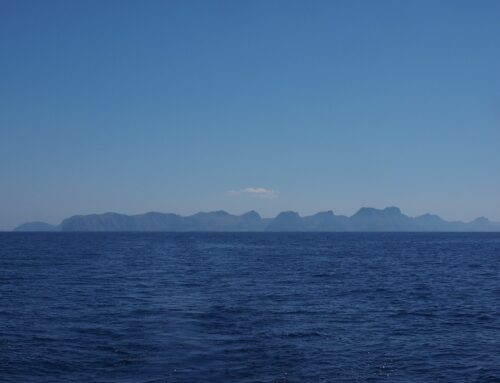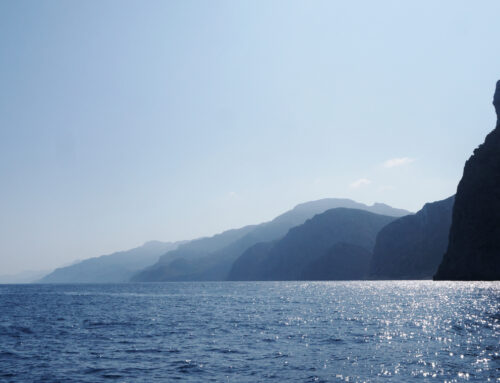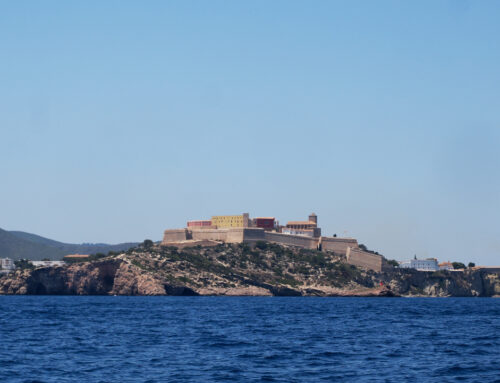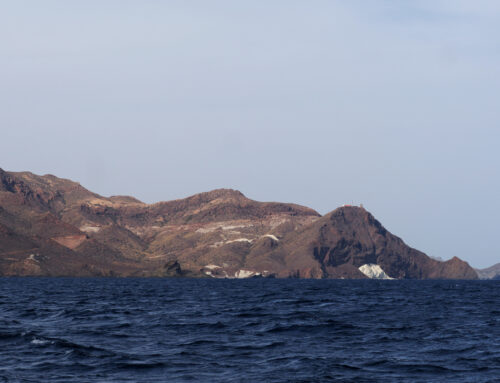A few days in ‘A Cidade de Cristal’
Arrival in A Coruña
Most Northern European sailors cross the Bay of Biscay in one go from England, the Channel, or from Brittany and make A Coruña their first port of call in Spain. Thus, on our arrival in A Coruña we were welcomed by other yachties with questions like “How was the crossing?”, “Any bad weather”, and “How long did you take?”. Sadly, our answers, “Easy”, “No”, and “A few hours”, made us immediately disappointing and uninteresting – we had come from the Ria de Cedeira, just around the corner, not from across a couple of hundred miles of legendarily temptestuous water.

The Tower of Hercules’ lighthouse. A welcome sight to many a sailor coming across the Bay of Biscay.
This is not unusual for us though. With Yuma carrying an Australian flag, we often get asked “Wow! Did you sail all the way from Australia…??”. The disappointment, and maybe even a sudden tinge of scorn, is almost palpable when we tell them honestly “No, we bought the boat in the UK...”. The enthusiasm leaves their voice and their interest wanes. We try to alleviate their disappointment at not having just met two sailors who have sailed halfway around the globe by adding that we are planning to sail her back to Australia but that brightness never returns to their eyes. Oh well.

The Rias we had crossed to get to A Coruña. Not quite like crossing the Bay of Biscay.
Given that it is near the most westerly point of Europe and Spain’s northwestern most port, A Coruña is also a port for waiting for suitable weather; to round Cabo Finisterre if you are heading south, or to head off across the Bay of Biscay if you are heading north. And that is what we were doing in A Coruña – waiting for a good weather window for heading south. Given the forecasts, we had a few days to explore the city’s sights before we could make our move.

A nice see-through somewhere in the old city.
A snapshot
The marina we stayed in is located right in the city centre, which made for easy walks to markets, visits to ice cream shops, and runs along the long promenade that follows the coastline around A Coruña’s old city-centre.

Av. Porto da Coruña, the promenade with ‘glass galleries’ in the background.
This promenade was the place to be and to be seen, and was packed with families hanging out in the late afternoon and early evening. It had a very friendly atmosphere and a beautiful backdrop of the famous A Coruña ‘glass galleries’, the houses with glass built-outs (enclosed verandahs).

Us trying to be seen, at the Av. Porto da Coruña.
During the day, the families were replaced by dogs walking their owners and hordes of tourists disembarking from enormous cruise ships which docked right next to the marina.

Horrid cruiseships, taking over the marina, and the city.
Luckily, these ships never stayed long but they certainly overwhelmed the place when they were in town. The combination of city life, industrial areas, the beaches, sea cliffs and beach culture, made the place feel familiar: we thought it was a bit like a boiled-down version of Sydney.

View towards Praza de María Pita.
The Tower of Hercules
The main landmark when approaching A Coruña by boat is, as is so often the case, the lighthouse. This particular lighthouse, the Tower of Hercules, is rather special though. It was built by the Romans in the 1st century AC based on the original plans of the lighthouse of Alexandria, and it the oldest known extant and functioning Roman lighthouse. According to an inscription in an original cornerstone, the tower was designed by a Roman architect as an offering to the Roman god of war, Mars. Strange, you would think the Romans would offer a lighthouse to Neptune, their god of the ocean. However, I guess they knew what they were doing because it is still standing and (apparently) it has been in consistent use since the 2nd century AC.

The rather steep walk to the Tower of Hercules.
Of course, this special lighthouse deserved a visit, so we hopped on our bikes and cycled along the promenade to the Tower. This was a very pleasant cycle with great views over the bay and to the northern Rias. Having arrived at the tower’s tickets office, we learned that, unfortunately, the tower’s viewing platform was closed due to strong winds. And we were too late to enter the exhibition inside.

One of the sculptures – it amplifies the sound of the sea. It made us think of an emu with its head stuck in the sand.
So instead, we walked around the tower, took in the sights, and discovered that the Culture Park around it was full of sculptures dedicated one way or another to the Tower of Hercules. These were more of less interesting, most of them less so than more, but the idea was nice.

Obelisco Millenium. Not quite the Tower of Hercules, but still impressive.
Casa de las Palabras
Whilst moseying around the sculpture park, we noticed a building that was a bit different from the Hercules’ sculptures. This was the Casa de las Palabras, the House of Words. Its name refers to the texts, in Latin, Greek, Arabic, Gaelic and Old Spanish, that are written on its walls relating to the city of A Coruña. Originally, in the 1930s during the Spanish Civil War, this was a Moorish cemetery for combatants of Maghrebi origin. Their remains were later removed and then repatriated; all that remains now are the words on the walls and garden inside them: a small peace park.
Doing city things in a Spanish city
Being in a larger town allowed us to do some city-things such as getting a new battery installed in my (F) dive watch. This took three trips to a very friendly jewellery where David tried in his best Spanish to explain that not only did it need a new battery, but being a dive watch, it also needed pressure testing. In the end, we succeeded and my watch is working again!

‘Polbo’, or Octopus sculpture seat. Very cool!
We also decided that after some pretty bad tapas and other mediocre Spanish meals, that it was time for some good food. After our yummy experiences in France, I decided to find another Michelin-recommended (not starred) restaurant for lunch. In France and Spain, these are eminently affordable and our limited experience of them in France had been excellent.

A rather uninspiring meal, yet again, in Spain.
Unfortunately, I did not check its location and to get there we needed to cycle up a very long and steep hill. Combined with a bit of rain, we arrived at the restaurant sweating like pigs and drenched like cats. Luckily, it didn’t matter as it was not too flash of an establishment; there was no place to hang our wet raingear (I guess normally people arrive here in cars…), the manager had a good scratch of his privates while keeping an eye on proceedings, one of the waiter needed to constantly double-check with the chef what he was actually serving, and another one having no idea where the scallops were coming from. None of this spoiled the fun and a good (but not particularly remarkable) meal was had by all.

Speccie after-lunch view towards A Coruña.
Afterwards, we walked around the headland and enjoyed the ocean views which we had missed out on at the lighthouse the day before. As a final treat, it was downhill all the way on the bikes back to Yuma!
Castelo de San Antón
On our final day in A Coruña we visited an old fortress which is located, as a proper fortress ought to be, right at the entry of the harbour.

The Castelo de San Antón.
The San Antón Castle was built in the 16th century to protect A Coruña from attacks of the sea, including of course the English. The latter, under the leadership of Francis Drake and with a bit of assistance from the Dutch Republic, were repeatedly defeated during the Siege of Coruña in 1589 by, shock-horror, civilians and women. The English deserted in droves after this humiliation, while the Spanish heroïne María Pita still has a prominent monument in the town hall square. The fortress remained a defensive structure, as well as a prison, up until the 18th century, after which it was turned into a quarantine facility for sailors returning with infectious diseases.

The Castelo had a large vaulted cistern to collect freshwater.
Now it is an interesting museum where we easily whiled away a few hours with various exhibits on the (pre-)history of A Coruña.








Fantastisch die vuurtoren.
Steeds als we langs min 12 lopen in Harlingen ( nee we gaan niet naar binnen 😋), denk ik aan David. 🤭
Mooi hè? Erg indrukwekkend. Haha, ja we hebben het ook nog vaak over min 12, dat was toch wel erg lekker ijs!